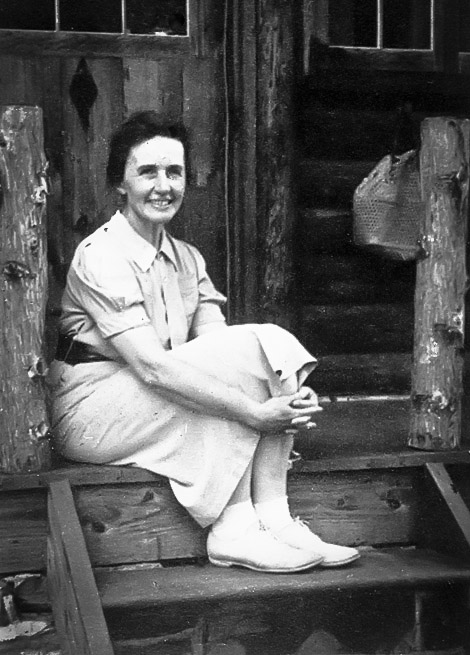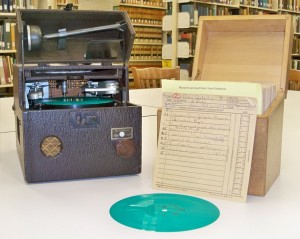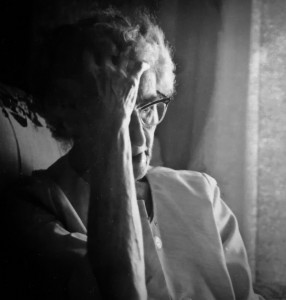The ballads collector of Lake Champlain
Journalist Marjorie Porter watched the old woman’s wrinkled hands spinning yarn and listened to the tune she was quietly humming as she worked. A cool breeze from across Lake George was stirring the humidity in the shade. It was 1941, and Porter, 32, had spent many summers with her family at the lake. Today, this exhibit of pioneer life in the Adirondack Mountains brought her to the spinning wheel of Lily Delorme.
“Mrs. Delorme, I’m Marjorie Porter. I’m a reporter for the Plattsburgh Daily Press (today’s Plattsburgh Press Republican). “That song you are humming, is that a Lake Champlain ballad,” Porter ventured.
“Grandma” Lily Delorme, as she was known, nodded yes, not pausing from her spinning or humming. Other visitors stood by watching her work.
Porter, wrote in her subsequent article, “Her story of pioneer life in the Adirondacks was set to a musical hum as she paced, now close to the big wheel, now away from it.”
“Would you allow me to record the song,” Porter asked. “Do you know the words?”
“Oh yes,” Delorme smiled looking up from her task. “I know a bunch of them.”
“Do you happen to know, by chance, a ballad called “The Banks of Champlain,” Porter asked.
“Why, yes, it went this way, ‘Twas autumn and round me the leaves were descending…”
“Her thin, reedy voice told the whole story in a score of verses, ” Porter wrote. “Grandma’s saga continued in lively conversation as I drove her home. She spoke of her grandfather, a Vermont pioneer named Gideon Baker, veteran of the War of 1812, and of his muzzle-loader and bullet mold from the war. We talked about how The Banks of Champlain was written by the wife of General Alexander Macomb during the Battle of Plattsburgh.
TRIBUTARY
Marjorie Porter was born in Port Henry on Lake Champlain in 1891, the daughter of Charles and Helen (Prescott) Lansing. Her great-grandfather, Wendell Lansing, founded the Essex County Republican in 1839 in Keeseville, as an organ of the Whig Party and its anti-slavery platform. They also owned the Plattsburgh Sentinel of which her grandfather, Abram Lansing, was editor. The paper became the Press-Republican in 1942.
She married Howard Guy Millington in 1912, and then Homer Porter in 1922. She had five children: Helen Millington (1913), John Millington (1915), Mary Elizabeth Millington (1918), David Porter (1922) and Philip Porter (1924).
Surrounded by journalists and other storytellers in her own family, she was naturally fascinated by the family stories about the Adirondack Mountains region of northern New York, and northern Vermont, forming the valley for Lake Champlain. Her many articles captured wonderful details which reader’s enjoyed. She became, over time, the region’s official historian, and began expanding her efforts to collect ballads and oral histories.
Porter wrote later that this encounter with Lily Delorme was “the seed for a constructive activity – the collection of folksongs, ballads and lore illustrative of life in the Adirondack Mountains and the adjacent Lake Champlain Valley.” She recorded more than 100 of Delorme’s songs (click link to hear original recording) on her new SoundScriber Recorder.
By the time Porter died in 1973, that collection consisted of 33 reel-to-reel tapes that held more than 450 recordings of folk ballads, lyrical folksongs, early hillbilly pieces, French Canadian songs and fiddle tunes from steamboat captains, loggers, farmers, lumber jacks, and trappers.
Copies of the recordings are at Archive of Folk Culture in the American Folk Life Center at the Library of Congress. The originals, along with Porter’s manuscript and photo collection, are at the State University of New York (SUNY) at Plattsburgh Special Collections where Porter’s SoundScriber discs have been digitized.
Porter recorded another “tradition bearer” named John Galusha, or “Yankee John” as he was known locally. He worked his whole life in the Adirondack mountains as a logger, farmer, forest ranger and guide. Starting at age sixteen and for decades afterwards, he’d spend the fall and winter months in the lumber camps, then work the Boreas, Hudson, Moose and Beaver Rivers in the springtime driving logs downstream to the mills. Summers were reserved for guiding and/or farming, and in later years, fire observing on Vanderwhacker Mountain. Then, back to the woods in the fall.
Click link to hear “Yankee John” Galusha singing one of his songs.
Word of her collection spread in folk music circles and Pete Seeger found his way to her home to hear some of the recordings. They provided the source material for albums by Pete Seeger (1960) and Milt Okun (1963). On “Champlain Valley Songs”, Seeger sings, The Banks of Champlain, which was originally sung by Delorme and recorded by Porter.
2008 interview with Pete Seeger by Porter’s granddaughter June Millington.
TRIBUTARY
Kathy Gill, daughter of Helen Millington, spent summers traveling with her grandmother, the ballads collector. She recently wrote this letter to her cousins who were meeting with the Special Collections staff to turn over personal photos and papers to the Porter archives. The letter offers many insights into the personality of Marjorie Porter.
GILL
She drove her trusty ’48 Studebaker coupe as we traveled to the newspaper offices in Keeseville and Plattsburgh where she dropped off her weekly columns. I remember climbing a long flight of rickety stairs at the back of the Keeseville press with the AuSable River thundering by underneath and shaking the stairs and even the door knob on the back door. I felt only those with real stories to tell would dare to enter. The door would open to a huge grimy room alive with monstrous, roaring machines pounding out the news with words typed all over these sheets of newsprint as they spewed them out in a deadline glut. I felt my humble nine-year old heart bow in respect. I had discovered my religion; my forebearers smiled and so did Grandma.
We visited ancient, ancient people way back in the hinterlands. She had a little machine which would record important stories and their versions of old, old ballads on a wax cylinder. She would mail it to a place in New York City and it would all be transferred to a small flexible bright-green disc which could be played on a record player. The ballads were sung by elderly folks with scratchy voices and they were hard to understand, but Grandma knew all of their folks songs and taught some of them to me as we drove along in the sweet little coupe, which was traded in, I might add, to my horror, in 1957, on a brand-new black Studebaker Skylark with red-leather interior.
Folk singers, such as Pete Seeger (who did not like kids!) came to visit now and then and I think Milt Oaken did also. She always fed them her delicious waffles or pancakes with real butter and maple syrup. She made the best doughnuts in the world.
She loved nothing more than talking to, and teaching others, about the history of the Adirondack Mountains and Lake Champlain. She knew the North Woods right down to the pine needles on the forest floor and was glad to share all she knew with others. Her eyes would light up with delight and a zeal that was far beyond her normal interaction with others.
She loved to hob-nob with others of like mind and could talk with zeal for hours.
She was the one who taught me about birds and the woods, old stories and ballads and she made the best egg-sald sandwiches in the world.
I will always love her for opening a whole different world for me, by the Grace of God. And I will never forget how she would stomp across Route 9 in Keene as we’d be leaving after Sunday services at the old Methodist church, muttering, “Ye gods, people. Don’t any of you know how to sing?” People would turn and look at her with mouths hanging open, they were so shocked!
She always smelled good, like soft put-away clothes from a cedar chest.
When she tucked me in at night, her breath was warm against my face as we said goodnight prayers and she would sing the first stanza of ‘Thank Thee Our Father’, a beautiful old-lady voice with a spring to it.
Her little vanity in her bedroom had a three-part mirror behind it with simple things at hand; a comb, a sterling silver hairbrush and the most simple and beautiful sterling silver hand mirror with her initials waltzing across the back. I would stand in her doorway and just stare at that scene; so spare, yet so beautiful, just as her best paisley dress was, and her poor mis-shapened spectator pumps. (She suffered from bunions.)
One time I dared reach over and pick up the mirror and look in it, then quickly tried to put it back just as it was. I wanted to see if I were beautiful, also. I only saw a kid with scraggly hair staring back with eyes too big. But, I knew her reflection was beautiful, yet stern.
And she was so tiny. I towered over her by the age of 10 or 11. Many times, she had to buy her clothes in the children’s department because there was nothing in her size in the women’s section. It was very frustrating for her.
I wish all of you could just hear how beautiful her voice was as she sang different goodnight songs each evening just before sleep came.
My happiest moment was the summer I arrived and I knew I finally really belonged in her library because I could read all by myself. I couldn’t wait to devour all the books I could possibly reach on tiptoe. I will forever be grateful to her for that wonderful, wonderful door to the rest of the world and beyond. She, in her somewhat stern way, totally changed my outlook on life in certain ways and it was good, and predictable and safe.
TRIBUTARY
Porter wrote a regular column on the history and folklore of region for these newspapers for many years. This excerpt is from the Plattsburgh Press-Republican, October 27, 1943.
PORTER
It was one of those hazy September days when mountain outlines are obscure against a smoky blue sky, sunshine lies hot on fields golden and red with stubble of oats and buckwheat, maples wave scarlet banners here and there along winding dirt roads on the hillsides, blue birds make splashes of color on nail fences, and calls of jays and crows are muted in the pines.
We were driving up the valley of the Saranac in mid-afternoon, our objective High Falls Gorge, just above Moffittsville and 18 miles from Plattsburgh. One more “some day” trip had materialized and the gorge, of which we had heard so many tales, was near at hand.
Here it was that in lumbering days, almost a century ago, river drivers fought those sudden terrible log jams, when immense sticks piled high in wild confusion between rock walls, and a single man must step out on the heaving mass to set the key log free. The other end of a rope tied around his waist was held, by a companion on shore, who watched with the utmost vigilance to snatch him into the air and back to the river bank, if he misjudged his step in leaping to safety. If he fell into that roaring inferno of water, boiling around grinding, tossing logs, he was lost, though he be the bravest river man of all and perhaps well-loved in camp for his Irish blarney and his gusty songs.
TRIBUTARY
Marjorie Porter left very little about herself. She wrote mostly about other people. “The recent family donations completed the collection and gave insights into the personality of Marjorie Porter, ” commented Debra Kimok, Librarian of Special Collections. “The folk music and oral histories are just rich with information. The visit of the grandkids helped my staff and I learn more about her and fill out the collection a bit more.”
Hannah Harvester, Program Director at Traditional Arts in Upstate New York (TAUNY) commented, “Marjorie Lansing Porter’s music collection is an extremely significant resource for anyone with an interest in traditional music or the cultural heritage of the Adirondacks and Champlain Valley. It was very helpful for us at TAUNY when we created our Adirondack Music website module, as it contains songs from diverse groups such as loggers, miners, Irish, Iroquois, and French Canadian groups, as well as oral histories recorded with many of the singers. Many of the songs were recorded just in time, before the tradition bearers passed away.”
Enjoy Pete Seeger’s recording of “Isabeau S’y Promeneau” (Isabeau went walking) a French Canadian ballad recorded by Porter.
SUNY Plattsburgh Special Collections Guide to the Marjorie Lansing Porter Papers:
Photographs – Recordings – Papers
Photo credits: SoundScriber by Debra Kimok, SUNY Plattsburgh Special Collections.
Black and white portrait of Porter in front of window by Michael McNamara, grandson.
Adirondack Ballads and Folk Songs by Lee Knight. Songs from the lumber woods, iron mines and farms. Collected by, and dedicated to, Marjorie Lansing Porter. Sung unaccompanied or with guitar. “My times with Marjorie were highlights of my life, not only in terms of the folksong collection, but just in being with her, her letters and talking on the phone. She had a way about her that taught me lots of subtle and not-so-subtle things.”
Songs to Keep. Treasures of an Adirondack Folk Collector — A new documentary project including film, album, book and concert tour featuring rare Adirondack Folk songs collected by Marjorie Lansing Porter being rediscovered and rerecorded after 60 years.



